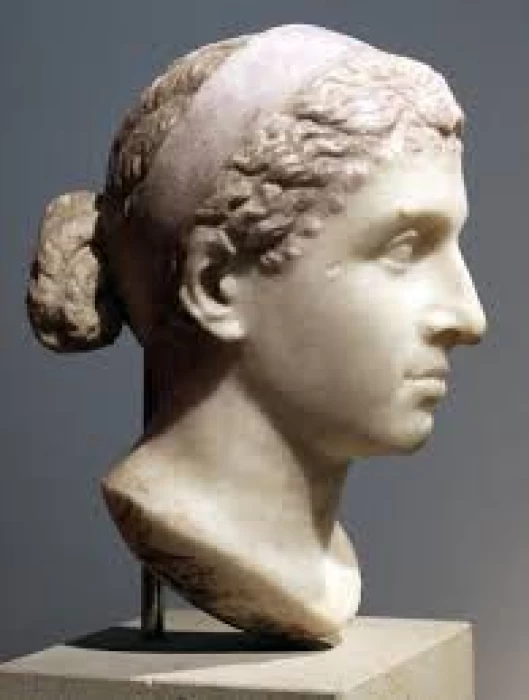
Queen Cleopatra | the Macedonian dynasty
Cleopatra was the daughter of Ptolemy XII, and succeeded him as queen in 51 BC, sharing the throne with her brother Ptolemy XIII. She was described as beautiful and charming, and the men who fell in love with her were captivated by her strong, charming personality, intelligence, and cunning. Egyptian history is very rich with the powerful Queens which you can learn more about during Egypt Classic Tours with certified Egyptologists. It is known that Cleopatra, who was 18 years old, was about eight years older than her brother, so she became the dominant ruler.
Cleopatra ruled for a few years. For example, she was the only one among the Ptolemaic family who took it upon herself to learn the Egyptian language at that time, and she resembled the goddess Isis and claimed that she embodied her life on earth, so she called herself "the new Isis", which reflects the extent of her political intelligence and seriousness in ruling Egypt successfully.
Furthermore, Cleopatra was a talented queen, she spoke several languages, led armies at the age of twenty-one, and was educated in Alexandria. She was also known for opening grain stores for her people during famines and lifting taxes on them. Egypt was a prosperous country at the time. Egypt's history is very distinctive and standstill till now represented in the Great temples and museums like in the two cities of Luxor and Aswan where you experience one of the best Egypt Nile Cruise Tours in the great Nile River.
King Ptolemy XIII fell under the influence of his advisors who worked to remove Cleopatra and expel her from Alexandria to monopolize power. She fled to eastern Egypt and was able to recruit an army of Bedouins to restore her position when she arrived in Pelusium (currently Port Said). Port Said recently is a port that attracts visitors from around the world during Port Said Shore Excursions to visit the Great Giza Pyramids. Caesar summoned both Ptolemy and Cleopatra to Alexandria and declared his support for the monarchy.
During that time. In November 48 BC, with Caesar and Cleopatra imprisoned in the royal palace, the people of Alexandria declared the younger royal sister. Queen of Egypt. Cleopatra and Julius Caesar spent a long winter imprisoned in the palace of Alexandria. During this Julius and Cleopatra became political allies and lovers. Cleopatra, now widowed, was restored to her throne with full Roman support. At dawn one day in mid-August 30 BC, one of Queen Cleopatra's servants offered her a cobra as the means of suicide after she heard of her husband, the Roman general Mark Antony's defeat in war.
Cleopatra's suicide is believed to have followed shortly after that of Mark Antony, and the ancient historian Plutarch wrote that they were buried in royal splendor in a tomb near Alexandria. Some believe that the tomb was buried deep under the sea after the earthquake. Queen Cleopatra was glorified by the Egyptians and the Egyptians called many places like Cleopatra Spring where you can go through Egypt Safari Desert to enjoy Siwa’s Vibes.
Cleopatra, the daughter of Ptolemy XII Auletes, also known as Cleopatra Philopator, was the final acting ruler of Egypt’s extinguishing Ptolemaic dynasty. (69 BCE) was an heir to the Ptolemaic Macedonian-Greek dynasty, which traced its lineage back to Ptolemy I Soter, a general of Alexander the Great. She is renowned as one of the most beautiful women in history, a poet, writer, and others. She is also known for seducing two of Rome’s most famous people, Julius Caesar and Mark Antony, and thus making a political impact on Rome. Her interesting life and the time of her reign have fascinated historians, artists, and authors from ancient times to today, making her one of the most iconic figures of the ancient world.
Cleopatra was the daughter of Ptolemy XII Auletes of Egypt. Who her mother is remains unknown, including whether or not she was a member of the Ptolemaic dynasty. Cleopatra was a well-educated and fluent speaker of many languages including Greek, Egyptian, and the ones mentioned above as well. On the contrary, other queens were trying to adjust to the culture of the Greek and were ruling with the Egytian’s structure of their kingdoms.
In 51 BCE, Cleopatra was named,, together with her younger brother andhusband,d Ptolemy XIII, as co-ruler of Egypt, following the Ptolemaic practice of sibling marriage. But their relationship could not go without struggles, which ultimately resulted in a rebellion. In her pursuit of the throne, she came across Julius Caesar, who had just entered Egypt in 48 BCE during the pursuit of Pompey the Great. Cleopatra is famous for smuggling herself into Caesar’s presence rolled up on a carpet, an event that has reached mythical status by now.
Cleopatra's collaboration with Julius Caesar was both personal and political. With assistance provided by Caesar, she was able to restore her throne and held the position of co-regent with her younger brother, Ptolemy XIV. A child, Ptolemy XV Caesar, with whom Cleopatra and Caesar were linked.
After the death of Julius Caesar in 44 BCE, Cleopatra came back to Egypt, and among the turmoil of the Roman Republic, she tried to entrench her authority. In 41 BCE, she got engaged with Mark Antony, one of Rome’s triumvirates, both romantically and politically. Their relationship was controversial and in the military perspective, it was a good strategy because it was intended to join the forces of Egypt and Rome against the mutual enemy.














